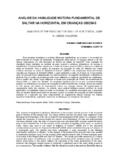| dc.contributor.advisor | Copetti, Fernando | |
| dc.creator | Bohrer, Daiana Camponogara | |
| dc.date.accessioned | 2017-10-06T13:58:32Z | |
| dc.date.available | 2017-10-06T13:58:32Z | |
| dc.date.issued | 2007-08-30 | |
| dc.date.submitted | 2007 | |
| dc.identifier.uri | http://repositorio.ufsm.br/handle/1/11822 | |
| dc.description | Artigo (especialização) - Universidade Federal de Santa Maria, Centro de Educação Física e Desportos, Curso de Especialização em Atividade Física, Desempenho Motor e Saúde, RS, 2007. | por |
| dc.description.abstract | This research investigated if significant differences in the process and the product of the horizontal
jump in function of the obesity exist. Ten obese children and ten not obese ones registered in the
Municipal net of Education of the city of Itaqui-RS had participated of this study. For evaluation of the
obesity the measures of corporal weight and stature, using themselves of scale and anthropometer
had been collected. Later, the index of corporal mass was calculated (IMC) and was applied the test to
jump in the horizontal line. For the analysis of the execution proceeding of the jump, an analytical
matrix, based was used in the matrix of Gallahue & Ozmun10 (2005) and in the described
developmental sequences for Haywood & Getchell9 (2004), which subdivided the jump in 5 phases of
3 movements each. The children had been categorized in each movement, in the following
classification: inefficient or efficient. For the analysis of the product of the jump the best ones resulted
in centimeters had been used. For the analysis of the data the tests for ratio of Primer had been used,
of normality of the Shapiro-Wilk and Test t of “Student”. The results point with respect to (1) a higher
considerable degree of inefficiency in the execution proceeding of the horizontal jump; (2) indices of
inferior performance in the obese children; (3) superiority in the motor performance of the boys.
However, this biological variable seems to contribute in significant way in the motor ability to jump in
the horizontal line. The results evidence that the obesity in such a way acts in favorable way in the process how much in the execution product it horizontal jump, being able to come to reecho in the subsequent phases of the enrollment of these children in practical systematic sporting, extending still more the differences in relation to the not obese ones. | eng |
| dc.language | por | por |
| dc.publisher | Universidade Federal de Santa Maria | por |
| dc.rights | Acesso Aberto | por |
| dc.rights | Attribution-NonCommercial-NoDerivatives 4.0 International | * |
| dc.rights.uri | http://creativecommons.org/licenses/by-nc-nd/4.0/ | * |
| dc.subject | Desempenho motor | por |
| dc.subject | Salto horizontal | por |
| dc.subject | Criança | por |
| dc.subject | Obesidade | por |
| dc.subject | Motor performance | eng |
| dc.subject | Horizontal jump | eng |
| dc.subject | Child | eng |
| dc.subject | Obesity | eng |
| dc.title | Análise da habilidade motora fundamental de saltar na horizontal em crianças obesas | por |
| dc.title.alternative | Analisys of the basic motor skill of horizontal jump in obese children | eng |
| dc.type | Trabalho de Conclusão de Curso de Especialização | por |
| dc.degree.local | Santa Maria, RS, Brasil. | por |
| dc.degree.specialization | Atividade Física, Desempenho Motor e Saúde | por |
| dc.description.resumo | Esta pesquisa investigou se existem diferenças significativas no processo e no produto do
salto horizontal em função da obesidade. Participaram deste estudo 10 crianças obesas e 10 não
obesas matriculados na rede Municipal de Ensino da cidade de Itaqui-RS. Para avaliação da
obesidade foram coletadas as medidas de peso corporal e estatura, utilizando-se de balança e
estadiômetro. Posteriormente, calculou-se o índice de massa corporal (IMC) e aplicou-se o teste de
saltar na horizontal. Para a análise do processo de execução do salto, foi utilizada uma matriz
analítica, baseada na matriz de Gallahue & Ozmun10 (2005) e nas seqüências desenvolvimentais
descritas por Haywood & Getchell9 (2004), a qual subdividia o salto em 5 fases de 3 movimentos
cada. As crianças foram categorizadas em cada movimento, na seguinte classificação: ineficiente ou
eficiente. Para a análise do produto do salto foram utilizados os melhores resultados em centímetros.
Para a análise dos dados foram utilizados os testes para proporção de Primer, de normalidade do
Shapiro-Wilk e o Teste t de “Student”. Os resultados apontam para (1) um grau consideravelmente
superior de ineficiência no processo de execução do salto horizontal das crianças obesas em relação
às não obesas; (2) índices de desempenho inferior nas crianças obesas; (3) superioridade no
desempenho motor dos meninos. No entanto, essa variável biológica parece contribuir de modo
significativo na habilidade motora de saltar na horizontal. Os resultados evidenciam que a obesidade
atua de maneira desfavorável tanto no processo quanto no produto de execução do salto horizontal,
podendo vir a repercutir nas fases subseqüentes do engajamento dessas crianças em práticas
esportivas sistemáticas, ampliando ainda mais as diferenças em relação às não obesas. | por |
| dc.publisher.country | Brasil | por |
| dc.publisher.initials | UFSM | por |
| dc.subject.cnpq | CNPQ::CIENCIAS DA SAUDE::EDUCACAO FISICA | por |
| dc.publisher.unidade | Centro de Educação Física e Desportos | por |



